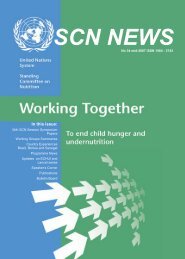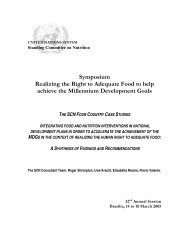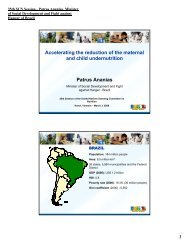Universal Salt Iodization (USI) - FTP Directory Listing
Universal Salt Iodization (USI) - FTP Directory Listing
Universal Salt Iodization (USI) - FTP Directory Listing
- No tags were found...
Create successful ePaper yourself
Turn your PDF publications into a flip-book with our unique Google optimized e-Paper software.
SPEAKER’S CORNERwww.unsystem.org/scn 71ergy intake. Generic benchmarks for saturated fats, trans fats, sodium and added sugars have been derivedfrom WHO recommendations*. Where appropriate, criteria for energy and dietary fibre are applied to specificfood categories.As much as possible generic criteria are applied across the board. However, for some product categories itwould be impossible to fully comply with those for technological or taste reasons. In order to stimulate productinnovation in these categories as well, a “best in class” approach was used, adapting some of the qualifyingcriteria to make them challenging but not prohibitive. This approach is stricter for “non-basic” (e.g. snacks)than for “basic” (e.g. bread) categories, thus positively discriminating those categories that contribute to theintake of beneficial nutrients. It is expected that, with ongoing innovation, these criteria will get stricter in thefuture.The question arises, of course, how far such a category-specific approach should be followed. Another questionis whether the “best in class” approach could lead to different criteria in different countries or regions.Such questions are to be answered by the scientific committee. An approach that weighs “positive” and“negative” nutrients against each other, as proposed in some other schemes, was rejected by the scientificcommittee as it has insufficient scientific basis. The qualifying criteria are dynamic. Periodically they will bereviewed by the scientific committee against new scientific insights, technological developments and marketsituations.Results and effectivenessThe Dutch Choices Programme has grown, within one and a half year, from three to 85 participants, amongwhich nearly all supermarket formulas and the leading catering companies. Over 1,500 products have beengranted the Choices stamp. And results are beginning to show: Eighty-eight percent of Dutch consumers recognisethe Choices stamp, 50% understand what it means, and some 70% frequently or incidentally buyproducts for their Choices stamp. A first market analysis, as well as claims by some of the participating companies,show that products carrying the Choices stamp have a better market performance – although it is tooearly to get a clear picture on sales figures relative to other products. First reports from participating companiesshow that tons of sugar, saturated fat and sodium have already been removed from products as a resultof product development aimed at compliance with the qualifying criteria.In order to get a well-founded insight in the effectiveness of the Choices Programme, a monitoring andevaluation programme is being set up under the supervision of two independent scientists, members of theDutch scientific committee (Prof. Jaap Seidell and Prof. Hans Brug). This will study effects on consumers(knowledge, recognition, behaviour) and producers (sales effects, changing product composition, innovationbased on qualifying criteria), and will attempt to calculate overall health effects.As the programme is being implemented in other countries, we intend to set up comparable monitoring andevaluation programmes. Thus we expect to come up with “hard evidence” that the Programme actuallyachieves what it aims for: to help the consumer to make the healthy choice, and to stimulate industry to improveits product portfolio.Unique prospectNo other front-of-pack labelling scheme offers the same value as the Choices Programme. It is simple, credible,science-based, globally applicable and accessible for all companies in food industry, retail and catering,including SME’s. It is a straight answer to the WHO’s call for action and can prevent a confusing proliferationof logo’s.ReferenceFeunekes GIJ, Gortemaker IA, Willems AA, Lion R and van den Kommer M (2008) Front-of-pack nutrition labelling: Testingeffectiveness of different nutrition labelling formats front-of-pack in four European countries. Appetite 50(1): 57-70.Contact: info@choicesinternational.org, www.choicesinternational.org* The criteria for individual products are less stringent than the recommendations for daily intake, as not every component of a dailydiet contributes to the intake of these nutrients.back to contents SCN NEWS # 35







